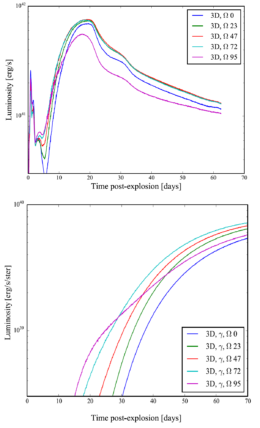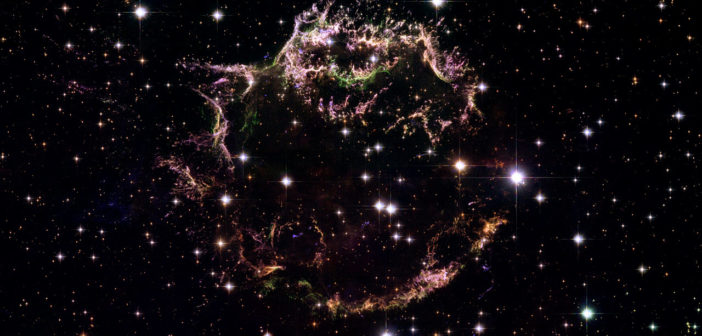Supernova explosions enrich the interstellar medium and can even briefly outshine their host galaxies. However, the mechanism behind these massive explosions still isn’t fully understood. Could probing the asymmetry of supernova remnants help us better understand what drives these explosions?

Hubble image of the remnant of supernova 1987A, one of the first remnants discovered to be asymmetrical. [ESA/Hubble, NASA]
Stellar Send-Offs
High-mass stars end their lives spectacularly. Each supernova explosion churns the interstellar medium and unleashes high-energy radiation and swarms of neutrinos. Supernovae also suffuse the surrounding interstellar medium with heavy elements that are incorporated into later generations of stars and the planets that form around them.
The bubbles of expanding gas these explosions leave behind often appear roughly spherical, but mounting evidence suggests that many supernova remnants are asymmetrical. While asymmetry in supernova remnants can arise when the expanding material plows into the non-uniform interstellar medium, it can also be an intrinsic feature of the explosion itself.

Simulation results clockwise from top left: Mass density, calcium mass fraction, oxygen mass fraction, nickel-56 mass fraction. Click to enlarge. [Adapted from Wollaeger et al. 2017]
Coding Explosions
The presence — or absence — of asymmetry in a supernova remnant can hold clues as to what drove the explosion. But how can we best observe asymmetry in a supernova remnant? Modeling lets us explore different observational approaches.
A team of scientists led by Ryan T. Wollaeger (Los Alamos National Laboratory) used radiative transfer and radiative hydrodynamics simulations to model the explosion of a core-collapse supernova. Wollaeger and collaborators introduced asymmetry into the explosion by creating a single-lobed, fast-moving outflow along one axis.
Their simulations showed that while some chemical elements lingered near the origin of the explosion or were distributed evenly throughout the remnant, calcium was isolated to the asymmetrical region, hinting that spectral lines of calcium may be good tracers of asymmetry.

Bolometric (top) and gamma-ray (bottom) synthetic light curves for the authors’ model for a range of simulated viewing angles. [Adapted from Wollaeger et al. 2017]
Synthesizing Spectra
Wollaeger and collaborators then generated synthetic light curves and spectra from their models to determine which spectral features or characteristics indicated the presence of the asymmetric outflow lobe. They found that when an asymmetric outflow lobe is present, the peak luminosity of the explosion depends on the angle at which you view it; the highest luminosity occurs when the lobe is viewed from the side, while the lowest luminosity — nearly 40% dimmer — is seen when the explosion is viewed “down the barrel” of the lobe. The dense outflow shades the central radioactive source from view, lowering the luminosity.
This effect also plays out in the gamma-ray light curves; when viewed down the barrel, the shading of the central source by a high-density lobe slows the rise of the gamma-ray luminosity and changes the shape of the light curve compared to views from other vantage points.
Another promising avenue for exploring asymmetry is a near-infrared band encompassing an emission line of singly-ionized calcium near 815 nm. Since calcium is confined within the outflow lobe in the simulation, its emission lines are blueshifted when the lobe points toward the observer.
The authors point out that there is much more to be done in their models, such as including the effects of shock heating of circumstellar material, which can contribute strongly to the light curve, but these simulations bring us a step closer to understanding the nature of asymmetrical supernova remnants — and the explosions that create them.
Citation
Ryan T. Wollaeger et al 2017 ApJ 845 168. doi:10.3847/1538-4357/aa82bd


1 Comment
Pingback: asymmetry in supernovae